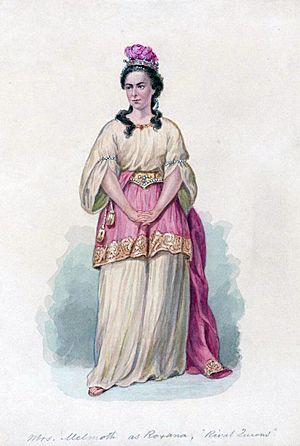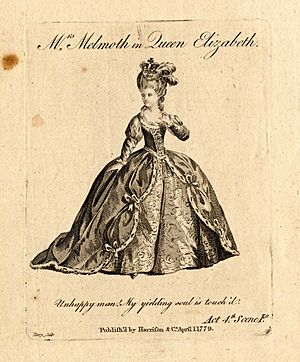Charlotte Melmoth facts for kids
Quick facts for kids
Charlotte Melmoth
|
|
|---|---|

Mrs Charlotte Melmoth as 'Roxana' in "The Rival Queens"
|
|
| Born | circa 1749 |
| Died | September 28, 1823 Brooklyn, New York |
| Occupation | Actress, teacher |
| Language | English, Irish |
| Nationality | English |
| Partner | Samuel Jackson Pratt (17??–1781; separated) |
Mrs. Charlotte Melmoth (around 1749 – 1823) was a famous English actress from the 1700s. She was known as "The Grande Dame of Tragedy on the Early American Stage." This means she was a very important and respected actress who played serious, dramatic roles in early American theater. After a good acting career in Great Britain and Ireland, she moved to the United States in 1793. There, she became one of the most well-known actresses of her time.
Contents
Early Life and Beginnings
We don't know much about Charlotte Melmoth's early life. She might have been the daughter of an English farmer. Her original family name is also not certain. She first became known in the late 1700s as "Mrs. Courtney Melmoth." She was part of an acting team with Samuel Jackson Pratt, who was a writer and actor. It's unclear if she took his stage name "Melmoth" or if it was her real name and he used it too.
Most people believe she was born in 1749, the same year as Pratt. Some stories say she was still in school when she met him. She reportedly started acting with Pratt after a marriage that might not have been official. Pratt's parents did not approve of their relationship. The couple traveled and performed in plays together. Sometimes, when they didn't have much money, they would tell fortunes to earn a living.
In 1773, they opened a theater in Drogheda, Ireland. This theater didn't do well and closed in three months. After that, they moved to London. In London, Charlotte Melmoth started to become a successful actress. She performed at famous theaters like Covent Garden and Drury Lane. From 1776 to 1779, they performed in cities like Edinburgh, London, and Birmingham.
Meeting Benjamin Franklin
From 1777 to 1778, Charlotte Melmoth and Pratt were in Paris. There, they met Benjamin Franklin, a famous American statesman and inventor. They were with Franklin in January 1778 when he gave a copy of his portrait to a friend. Charlotte Melmoth wrote a poem about wishing she had a copy too. Pratt sent the poem to Franklin, who apologized for not realizing she wanted one.
At this time, the couple was having money problems. Pratt had borrowed money from friends. On January 29, 1778, Pratt asked Franklin for a loan, and Franklin agreed. Pratt asked for more money several times. Franklin helped them but also said their requests were difficult for him. In May, the "Melmoths" returned to England. Pratt wrote to Franklin saying they couldn't pay him back. After this, their friendship with Franklin seemed to end. By 1781, Pratt and Melmoth had separated. Charlotte Melmoth kept her stage name and continued acting in Ireland. In 1793, she moved to the United States.
Acting Career Highlights
In Britain and Ireland
Charlotte Melmoth first performed on stage in May 1773. This was at The Smock Alley Theatre in Dublin, Ireland. She played Monimia in a play called The Orphan. Later in 1773, she and Pratt opened their own theater in Drogheda. They performed The Merchant of Venice, with Melmoth as Portia. But the theater failed, and they moved to London.
In February 1774, she made her first appearance at Covent Garden. She played Calista in The Fair Penitent. A magazine called Westminster Magazine praised her acting. They said she was "young and handsome" and had "great feeling." They believed she would become a "great ornament to the theatre." Later that year, she played Roxana in The Rival Queens. This was a role she would play many times. She also performed as Queen Elizabeth in Henry II and Hermione in A Winter's Tale.
In 1776, she performed in Edinburgh with her husband. There, she played many important roles. These included Alicia in The Tragedy of Jane Shore and Viola in Twelfth Night. In Edinburgh, she also played Lady Macbeth for the first time. This role later became one of her most famous.
In November 1776, she made her debut at Drury Lane as Lady Macbeth. The next year, she played Roxanne again in The Rival Queens. This was her last performance in London for a while. The following year, she and her husband were in Paris. Then, in 1778 and 1779, they performed in Edinburgh. Here, Melmoth started to play funny roles too, like Lady Sneerwell in The School for Scandal. Before this, she mostly played serious, tragic characters.
By 1780, the couple returned to the Smock Alley Theatre in Dublin. This is where Charlotte Melmoth's acting career had begun. They performed together for the last time in 1781. After this, they separated and never saw each other again. Charlotte Melmoth then toured major cities in Ireland. She performed in Cork, Limerick, Waterford, Derry, and Belfast. She eventually settled in Dublin. She continued to perform in various Dublin theaters until 1789.
In 1786, Charlotte Melmoth became a Catholic. Some people thought she did it to sell more tickets in a Catholic city. However, most people who wrote about her believe her conversion was sincere.
In July 1789, Charlotte Melmoth announced she was leaving the theater. She planned to open a school to teach a craft called filigree work to ladies. But the school was not successful. So, in 1793, she moved to the United States to start acting again.
In America
Charlotte Melmoth arrived in New York in March 1793. She was advertised as being "From the Theatres Royal of London and Dublin." She gave a series of dramatic readings and Shakespearean speeches. These events were held at Corre's Hotel in April. The London Register newspaper said her performances brought "infinite delight to every rational mind."
Later that year, she joined a group called Hodgkinson's 'American Company'. She performed at the John Street Theatre in New York. Her first show there was on November 20, 1793. She played Euphrasia in The Grecian Daughter. Over the next five years, she played many leading tragic roles for this company. Her most famous role was Lady Macbeth. People loved her acting, and she became a "universal favourite."
A famous American theater manager, William Dunlap, called her "the best tragic actress the inhabitants of New York, then living, had ever seen." Another actor, William Wood, said she had a "fine face and powerful voice." He added that she had a wonderful way of showing sad feelings. This left a lasting impression on audiences.
In 1794, she refused to speak the ending speech of a new opera called "Tammanay". She reportedly didn't like its patriotic message. The New York Journal called for people to boycott her shows. They said she should not be allowed to perform in New York again. However, her popularity did not decrease. When the Park Theatre, New York, opened in 1798, Charlotte Melmoth became one of its main actresses.
As she got older, in her late 40s, her body changed. She was no longer as slender as she had been. One night, while playing Euphrasia, she invited another character to stab her. She said, "Strike here! Here's blood enough!" The audience laughed because of her size. After that, she removed that line from her performances.
Realizing her body had changed, she started playing older, more mature roles. She was very good at these parts. She stayed with the Park Theatre until 1805. Then, she moved to the Chestnut Street Theatre in Philadelphia.
In 1811, she was traveling to perform at the Olympic Theatre in New York. She was in a carriage accident and broke her arm badly. There were even rumors in the newspapers that she had died. Her arm did not heal well. Because of this, Charlotte Melmoth sadly had to stop her acting career.
On August 12, 1812, she announced her retirement from the stage. She gave her last performance. This was a 'benefit performance' to raise money for her retirement. She played Fiammetta in The Tale of Mystery at the Olympic Theatre.
Later Life and Legacy
After retiring in 1812, Charlotte Melmoth supported herself. She owned a respectable tavern that she had bought while still acting. She also opened a school for public speaking on Washington Street in New York. Later, she bought a small house in Red Hook Lane, Brooklyn. This is now Carroll Street. There, she opened a boarding house and a school. She ran this school until she passed away.
Her students included children from some of Brooklyn's wealthiest families. These were families like the Cornell, Pierpoint, Cutting, Jackson, and Luquer families. John McCloskey, who later became a Cardinal Archbishop of New York, was one of her students.
Charlotte Melmoth passed away at age 74 on September 28, 1823. She was buried in the Catholic graveyard near the original St. Patrick's Old Cathedral in Manhattan. An obituary in the Washington Quarterly newspaper praised her. It said her acting talent, especially in serious roles, was widely recognized. It also mentioned that she was highly respected for her excellent personal character.
Images for kids



